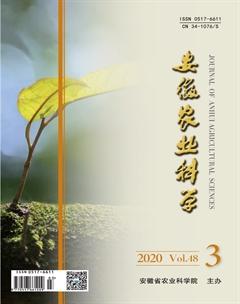氟虫腈的毒作用机理及其残留的检测方法
侯莉莉 李艳 张冷思

摘要 氟虫腈是一种以γ-氨基丁酸(GABA)受体为靶点的广谱苯吡唑杀虫剂和兽药,在世界范围内得到了广泛的应用。然而,越来越多的研究表明,氟虫腈在动植物以及环境中会代谢生成毒性较高的砜化物或亚砜化物,对生态环境、生态系统甚至人类健康都产生了一定的影响。对氟虫腈的理化性质和毒作用机理进行了较为全面的阐述,并对目前氟虫腈及其代谢物在农产品、畜产品以及水产品中常用的检测方法进行探究,以供后期参考。
关键词 氟虫腈;毒作用机理;残留;检测方法
中图分类号 TS207.5+3 文献标识码 A 文章编号 0517-6611(2020)03-0008-03doi:10.3969/j.issn.0517-6611.2020.03.003
Abstract Fipronil is a broadspectrum phenylpyrazole insecticide and veterinary drug targeting the γaminobutyric acid (GABA) receptor, which has been widely used across the world. However, more and more studies have shown that fipronil metabolizes to produce sulfone or sulfoxide in animals and plants as well as in the environment, which has a variety of toxic effects on the ecological environment, ecosystem and even human health. In this review, the physical and chemical properties and toxic mechanism of fipronil were described comprehensively, and the commonly used detection methods of fipronil and its metabolites in agricultural products, livestock products and aquatic products were summarized as reference in the later stage.
Key words Fipronil;Toxic mechanism;Residue;Detection method
氟蟲腈,作为一种广谱杀虫剂,在20世纪90年代中期开始得以应用,主要用于治理农作物害虫和对动物寄生虫进行消杀。虽然氟虫腈具有良好的杀虫效果,但是越来越多的研究表明,氟虫腈及其代谢物在水和土壤中降解缓慢,对生态环境造成一定的影响[1-3]。此外,随着人们对食品安全的要求越来越高,氟虫腈的农药残留问题也受到人们的重视。笔者从氟虫腈的理化性质入手,重点阐述了氟虫腈的毒作用机理,并且列举了目前常用的检测氟虫腈农药残留的方法,以期为未来的检测过程提供参考。
1 氟虫腈的理化性质
氟虫腈是一种苯基吡唑类杀虫剂,化学名称为(RS)-5-氨基-1-(2,6-二氯-a,a,a-三氟-对-甲苯基)-4-三氟甲基亚磺酰基吡唑-3-腈,外观为白色固体,熔点200~201 ℃,难溶于水,易溶于有机溶剂,如丙酮、二氯甲烷等。在pH=5、7的水中稳定,在pH=9时缓慢水解,农药半衰期(DT50)约为28 d,在太阳光照下缓慢降解,但在水溶液中经光照可快速分解。
2 氟虫腈的毒作用机理
氟虫腈作为一种广谱苯吡唑杀虫剂和兽药,在世界范围内得到了广泛的应用。氟虫腈是一种以γ-氨基丁酸(GABA)受体为靶点的杀虫剂,对昆虫有较好的选择性毒性。然而,由于氟虫腈的广泛使用及不正确使用导致水和土壤污染。越来越多的研究表明,氟虫腈对各种水生生物具有很高的毒性[4]。先前的研究表明,氟虫腈对水生生物、家蚕、蜜蜂等都具有较强的毒性,而且氟虫腈能够刺激啮齿类动物甲状腺激素的分泌而可能导致甲状腺癌。此外,氟虫腈对人体的神经、消化和循环系统都有一定的影响。更重要的是,氟虫腈在外界环境中能够代谢生成毒性更高的氟虫腈砜和氟虫腈亚砜等化合物,其结构式见图1。
γ-氨基丁酸(GABA)是成熟脊椎动物和无脊椎动物中枢神经系统中的主要抑制性神经递质。GABA受体有两类:GABAA和GABAB[5]。作为配体门控离子通道,GABAA受体结合GABA,从而导致膜对氯离子的通透性增加,引发神经元的超级化,抑制和降低神经元的活性,使得神经信号传递抑制[6]。GABAB受体被激活后,通过偶联G-蛋白而减少钙内流、增加钾外流、降低细胞内环磷酸腺苷水平,从而抑制兴奋性递质的释放,使得突触后膜的超级化和阻碍突出囊泡的募集。虽然GABA门控氯通道在脊椎动物和无脊椎动物的中枢神经系统中都有表达,但相对于脊椎动物GABAA受体而言,氟虫腈对昆虫GABA受体的亲和力要高得多[7],与哺乳动物GABA调节的氯通道的结合亲和力降低,提高了对昆虫的选择性,并增加了其安全性[8]。如1 μmol/L的氟虫腈可完全抑制蜚蠊GABA受体离子流,但对大鼠神经细胞GABA受体离子流的抑制率仅有30%,其IC50为1.6 μmol/L[9]。此外,谷氨酸激活的氯通道也是氟虫腈的靶目标[10]。除了GABA受体外,氟虫腈对无脊椎动物的作用比脊椎动物更有效,因为无脊椎动物中存在哺乳动物中没有的谷氨酸激活的氯通道,比如昆虫[11-12]。 氟虫腈干扰GABA门控通道的功能,并通过靶向GABA-门控氯离子通道破坏正常神经元的流入,干扰中枢神经系统的正常功能[13],使昆虫如蚜虫、叶蝉、飞虱、鳞翅目幼虫、苍蝇和鞘翅目昆虫致毒,因此可用于土壤或叶面喷洒[14]。甘氨酸受体可能是氟虫腈新的脊椎动物毒性靶点。甘氨酸受体是氨基酸神经递质甘氨酸的电离受体,通过氯电流产生作用。甘氨酸受体作为中枢神经系统中分布最广泛的抑制性受体之一,在介导脊髓和脑干的抑制性神经传递中起着至关重要的作用[15]。先前的研究表明,氟虫腈完全抑制人α1、α1β、α2和α3甘氨酸受体亚型,与其在脊椎动物GABAA受体上的作用相似,显示了所有人类甘氨酸受体亚型都可能是氟虫腈的毒性靶点[16]。
[3] 陸贻通,周培,吴银良,等.锐劲特在菜地生态系统中的残留动态研究[J].环境污染与防治,2001(5):219-221,231.
[4] TAILLEBOIS E,ALAMIDDINE Z,BRAZIER C,et al.Molecular features and toxicological properties of four common pesticides,acetamiprid,deltamethrin,chlorpyriphos and fipronil[J].Bioorganic & medicinal chemistry,2015,23(7):1540-1550.
[5] FATEMI S H,FOLSOM T D.GABA receptor subunit distribution and FMRPmGluR5 signaling abnormalities in the cerebellum of subjects with schizophrenia,mood disorders,and autism[J].Schizophrenia research,2015,167(1/2/3):42-56.
[6] CHEBIB M,JOHNSTON G A.GABAactivated ligand gated ion channels:Medicinal chemistry and molecular biology[J].Journal of medicinal chemistry,2000,43(8):1427-1447.
[7] STEHR C M,LINBO T L,INCARDONA J P,et al.The developmental neurotoxicity of fipronil:Notochord degeneration and locomotor defects in zebrafish embryos and larvae[J].Toxicological sciences,2006,92(1):270-278.
[8] BADGUJAR P C,CHANDRATRE G A,PAWAR N N,et al.Fipronil induced oxidative stress involves alterations in SOD1 and catalase gene expression in male mice liver:Protection by vitamins E and C[J].Environmental toxicology,2016,31(9):1147-1158.
[9] 胡国新,陈晓宇,周红宇,等.氟虫腈及其砜化物在兔体内的毒物代谢动力学[J].中国药理学与毒理学杂志,2006,20(4):356-360.
[10] NARAHASHI T,ZHAO X L,IKEDA T,et al.Glutamateactivated chloride channels:Unique fipronil targets present in insects but not in mammals[J].Pesticide biochemistry and physiology,2010,97(2):149-152.
[11] NARAHASHI T,ZHAO X,IKEDA T,et al.Differential actions of insecticides on target sites:Basis for selective toxicity[J].Human & experimental toxicology,2007,26(4):361-366.
[12] SIMONDELSO N,AMARALROGERS V,BELZUNCES L P,et al.Systemic insecticides(neonicotinoids and fipronil):Trends,uses,mode of action and metabolites[J].Environ Sci Pollut Res Int,2015,22(1):5-34.
[13] GUNASEKARA A S,TRUONG T,GOH K S,et al.Environmental fate and toxicology of fipronil[J].Journal of pesticide science,2007,32(3):189-199.
[14] MOHAMED F,SENARATHNA L,PERCY A,et al.Acute human selfpoisoning with the Nphenylpyrazole insecticide fipronilA GABAgated chloride channel blocker[J].J Toxicol Clin Toxicol,2004,42(7):955-963.
[15] LYNCH J W.Molecular structure and function of the glycine receptor chloride channel[J].Physiological reviews,2004,84(4):1051-1095.
[16] ISLAM R,LYNCH J W.Mechanism of action of the insecticides,lindane and fipronil,on glycine receptor chloride channels[J].British journal of pharmacology,2012,165(8):2707-2720.
[17] The European Commission.Commission regulations(EU)No 750/2010 of 7 July 2010,amending annexes II and III to regulation(EC)No 396/2005 of the European parliament and of the council as regards maximum residue levels for certain pesticides in or on certain products(Text with EEA relevance)[J].Official journal of the European Union,2010,220:1-56.
[18] The Japan Food Chemical Research Foundation.Maximum residue limits(MRLs)list of agricultural chemicals in foods[DB/OL].[2018-02-24].http://db.foodmate.net/kending/agrlist.php?lang=zh&agrichem=.
[19] 中华人民共和国农业部种植业司.中华人民共和国农业部公告第1157 号[A/OL].(2009-02-25)[2018-02-24].http://jiuban.moa.gov.cn/zwllm/tzgg/gg/200902/t20090227_1226994.htm.
[20] 中华人民共和国国家卫生和计划生育委员会.食品安全国家标准 食品中农药最大残留限量:GB 2763—2016[S].北京:中国标准出版社,2016.
[21] 丁慧瑛,谢文,刘海山.植物性食品中锐劲特残留量的检测方法研究[J].分析测试学报,2005,24(5):113-115.
[22] TSUKIOKA T.Deteimination of fipronil and its metabolite MB46513 in agricultural products[R].Bulletin of the Nagano Research Institute for Health & Pollution,2003.
[23] 周晓冬,余兵,胡进.豆类蔬菜中氟虫腈残留分析方法的研究[J].農业环境科学学报,2007,26(S1):211-214.
[24] PARAMASIVAM M,CHANDRASEKARAN S.Determination of fipronil and its major metabolites in vegetables,fruit and soil using QuEChERS and gas chromatography-mass spectrometry[J].International journal of environmental analytical chemistry,2013,93(11):1203-1211.
[25] 白宝清,李美萍,张生万.QuEChERS-DLLME-高效液相色谱法测定蔬菜中溴虫腈和氟虫腈残留[J].食品科学,2014,35(24):254-258.
[26] 高蓉,陈景衡,赵人峥.河虾体中氟虫腈残留量气相色谱法测定[J].中国公共卫生,2005,21(5):624.
[27] 陈珊珊,丁丞,郭立新,等.气相色谱-负化学电离-质谱联用技术检测痕量氟虫腈及代谢物的漂移对池塘水和虾体的影响[J].质谱学报,2013,34(5):274-281.
[28] 陈志涛,丁立平,吴文凡,等.分散固相萃取-气相色谱法测定水产品中氟虫腈和丁烯氟虫腈的残留[J].农药,2014,53(12):904-905.
[29] 吕磊,何力,甘金华,等.分散固相萃取-气相色谱法测定水产品中氟虫腈残留[J].分析试验室,2015,34(7):847-849.
[30] 宁霄,金绍明,高文超,等.QuEChERS-超高效液相色谱-串联质谱法测定动物源性食品中氟虫腈及其代谢物残留[J].分析化学,2018,46(8):1297-1305.
[31] 王艳丽,陈克云,梁秀清,等.分散固相萃取/气相色谱质谱法测定动物源性食品中的氟虫腈及其代谢物[J].分析测试学报,2018,37(4):440-445.
[32] 沈伟健,柳菡,张睿,等.气相色谱-负化学源质谱法测定禽蛋及蛋制品中氟虫腈及其代谢物[J].色谱,2017,35(12):1224-1228.
[33] 吕冰,尹帅星,陈达炜,等.QuEChERS-四极杆/静电场轨道阱高分辨质谱测定动物性食品中氟虫腈及其代谢物残留[J].分析测试学报,2017,36(12):1424-1430.

